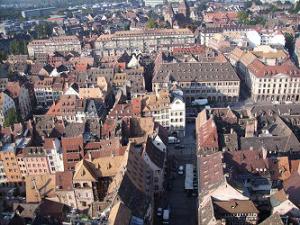Old town around the Cathedral
The old town of Strasbourg, surrounding the Cathedral of Our Lady, is the city centre and the most important part to do shopping in the Alsation metropole. It is located between Place Broglie, Place Gutenberg and Place Kléber.
Besides lots of small streets in the old town, there are some bigger public places and the Grand'Rue which are absolutely worth to be seen.
Place Broglie is the former place for military parades and horse markets. Its name comes from the governor Maréchal de Broglie. In December, you will find here a part of the famous Christmas market of Strasbourg. In the Banque de France, which is located at this place, Rouget de Lisle sang for the first time his hymn "Marseillaise" in 1792. On the opposite of that building, you will find the Town Hall, created in the style of the 18th century. Nearby, there is the Théâtre Municipal which was built in 1804. The impressive entrance hall with several pillars showing the six muses was created by Landolin Ohnmacht in 1821.
At Place Gutenberg, you will find the most important building of the renaissance in Strasbourg, the chamber of commerce.
Place Kléber was once, during the French Revolution, the place for public executions with the guillotine. Today, the place is surrounded by pretty buildings dating from the period of promoterism. At the northern edge, one can find "Aubette", the former main police station, where is today a restaurant and café.
Grand'Rue is the oldest street in Strasbourg and yet for the Romans, it was an important military axe that went from Saverne to the Place of the Cathedral. On the long of this street, there are a lot of nice workmen houses dating from the 18th century. Oriental shops and bakeries offer arabic specialities and flat breads.
Jew Street is a narrow street behind the cathedral, where lots of small boutiques are located. Once, it was the centre of the Jewish district in Strasbourg and there was a synagogue and a school in house number 30. During the 13th century, the Jewish community was protected by the German emperor, an expensive priviledge. Lots of workmen, dealers and grocers lived in Jew Street at that time. During the 14th century, the community grew fast, but with the arriving of the plague, the growing antisemitism became more and more obvious. In 1349, about 2000 Jews died in the flames of the stake.

